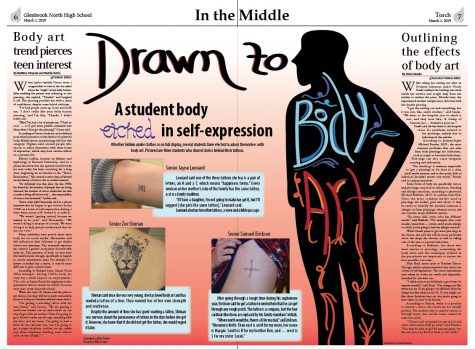Body art trend pierces teen interest
 When junior Isabella Grosso wore a cropped shirt to school, she was asked about the “staple” in her belly button. After realizing the person was referring to her piercing, she replied, “Thanks” and laughed it off. Her piercing provides her with a sense of confidence, despite some initial criticism.
When junior Isabella Grosso wore a cropped shirt to school, she was asked about the “staple” in her belly button. After realizing the person was referring to her piercing, she replied, “Thanks” and laughed it off. Her piercing provides her with a sense of confidence, despite some initial criticism.
“I’ve had people come up to me and [tell] me, ‘I don’t really like your belly button piercing,’ and I’m like, ‘Thanks, I didn’t really ask.’
“[But] I’ve had a lot of people say, ‘That’s so cool,’ … so [I get] more positive comments now [than when I first got the piercing],” Grosso said.
According to Grosso, body art can be defined as an artistic presence on the exterior of a person’s body. Mainly tattoos and piercings fall into this category. Stigmas exist around people who choose to adorn themselves with these forms of expression, which may have various effects on a person’s life.
Felicity Lufkin, lecturer on folklore and mythology at Harvard University, said in a phone interview that the upward trend in body art seen today has been occurring for a long time, beginning an era known as the “Tattoo Renaissance.” She created a tattoo class at Harvard on the history of tattoos due to student interest.
“It’s definitely true that since the late 1960s [in America], the number of people that are being tattooed, the number of tattoo artists that are able to make a living off tattoos and … the respectability of tattoos has increased,” Lufkin said.
Tattoo artist Jalil Hernandez said in a phone interview that he began to get tattoos in the 1980s as a form of self-expression during a time when many still viewed it as radical.
“We weren’t [getting tattoos] because we wanted to be cool,” said Hernandez. “We weren’t doing it because of a trend. We were doing it to help people understand that we are our own.”
Many celebrities have posted about their body art on social media. Hernandez said this influences their followers to get similar tattoos and piercings. The increased exposure has created a greater acceptance of youth with body art. This presence of body art may have life ramifications, though, specifically in regards to certain employment areas. For example, if a lawyer or banker has a tattoo, it may be more difficult to gain a client’s trust.
According to Richard Lyon, Sunset Foods office manager, having visible body art only has a small impact on employment. The rule at Sunset Foods for employees is that permanent tattoos cannot be visible because they may seem unprofessional.
When she turns 18, Grosso said she plans to get tattoos, but they will be in easily concealable places so it does not interfere with her career choice.
“I’m getting a matching tattoo with my best friend,” said Grosso. “We are getting a sunflower behind our ear and a heart on our ring finger, like an outline. Then I’m going to get a [flower] under my rib cage, matching with my sister and my mom. I’m going to wait a little bit for the next two, but I’m going to get a paper airplane outline on my ankle and three elephants holding each other’s tails on my [thigh].”

